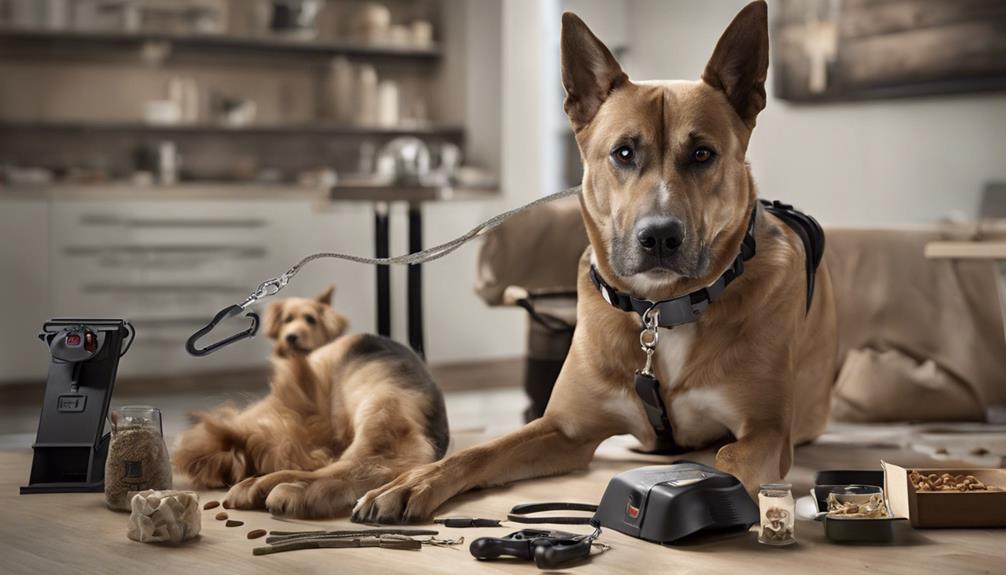To do well in e-collar dog training, start by picking a reliable brand like Dogtra or Garmin for quality. Choose a collar with adjustable levels for customized intensity that fits your dog comfortably. Establish a routine for collar usage, learn its features, and introduce it slowly. Understand the Remote Transmitter functions, stay consistent with commands and positive reinforcement, and gradually increase stimulation levels based on your dog’s reactions for effective training. Consistency is crucial, so set a regular training schedule and seek professional guidance for extra support to succeed in e-collar training. Get the best results by following these tips and using the right tools!
This comprehensive approach to e-collar training guarantees successful outcomes and a positive experience for both you and your dog.
Key Takeaways
- Establish a consistent routine for collar use before training sessions.
- Gradually introduce the e-collar to your dog to ensure comfort.
- Utilize positive reinforcement techniques alongside e-collar training.
- Monitor progress, adjust strategies, and track improvements consistently.
- Seek professional guidance for valuable insights and support in mastering e-collar training.
Choosing the Right E-Collar
When selecting an e-collar for your dog, prioritize reputable brands like Dogtra, TriTronics, Garmin, and SportDog for reliability and effectiveness. These brands are known for producing quality e-collars that can aid in your training efforts.
Look for collars with adjustable levels so you can tailor the intensity to your dog's needs. Having options like shock, vibration, and tone modes can provide versatility in your training approach.
Additionally, make sure the collar fits comfortably around your dog's neck to prevent any discomfort during use. A well-fitted collar is essential for successful training sessions.
Preparing for E-Collar Training

To prepare for e-collar training, establish a consistent routine for putting on the collar before each training session. This routine will help your dog associate the collar with the training process.
Familiarize yourself with the specific buttons and settings of the e-collar model you're using to make sure you use it correctly during training. It's important to introduce the e-collar gradually to your dog and not rush into using it without proper preparation.
Wear the collar every time your dog goes outside or for a walk, even if you're not using it for training at that moment, to help your dog get accustomed to it. Remember that positive reinforcement training should always be the foundation of your training sessions, even when incorporating electronic collars.
Understanding E-Collar Features
As you progress with your e-collar training journey, acquainting yourself with the diverse features of e-collars is crucial to enhancing your training effectiveness. Understanding the following features will help you maximize the potential of this valuable training tool:
- Adjustable Stimulation Levels: E-collars typically offer a wide range of customizable stimulation levels, allowing you to adjust the training intensity to your dog's needs accurately.
- Remote Transmitter: The Remote Transmitter is the device you use to send signals to the Receiver Collar your dog wears. Mastering its functions will enable you to communicate effectively with your furry companion during training sessions.
- Waterproof Design: Choosing a water-resistant e-collar guarantees durability and enables you to train your dog in various environments without worrying about water damage.
- Range Capability: Some e-collars have an impressive range of up to several hundred yards, giving you the flexibility to train your dog effectively even at a distance.
Implementing Effective Training Techniques

When implementing effective e-collar training techniques, remember to start with basic commands to establish a foundation for learning.
Timing is vital in using the e-collar as a reinforcement tool to correct behaviors effectively.
Consistency in your training approach, combining verbal commands with e-collar stimulation, is key to your dog's understanding and progress.
Basic Commands for E-Collar
Implementing effective training techniques with the e-collar involves starting with teaching foundational commands like sit, stay, come, and heel. To guarantee successful training, follow these steps:
- Use consistent verbal cues alongside e-collar stimulation to reinforce the behavior effectively.
- Practice commands in various environments to generalize the behavior and ensure reliability.
- Gradually decrease e-collar usage as your dog becomes more proficient in responding consistently.
- Monitor your dog's response to e-collar training and adjust stimulation levels based on their reactions for best results.
Timing Is Crucial
For effective e-collar training, mastering the timing of corrections is important for clear communication and reinforcing desired behaviors. Immediate corrections are vital in e-collar training as they help your dog connect their actions with consequences.
Delivering stimulation or commands precisely when the behavior occurs is key to effective training techniques. Consistent timing is significant to make sure that your dog understands what they're being corrected for. Delayed responses or corrections can confuse your dog and slow down training progress.
Your training success hinges on precise timing to establish a strong link between their actions and the outcomes. By focusing on timing, you can effectively shape your dog's behavior and progress in their training journey.
Consistency in Training
To guarantee effective e-collar training, maintaining consistency in utilizing the device for specific commands is crucial in reinforcing desired behaviors and promoting quick learning in your dog. Consistency in training involves using the e-collar at the same level of stimulation for a particular command until your dog consistently responds.
Implementing effective training methods means reinforcing commands with the e-collar in a consistent manner to avoid confusion. Consistency helps your dog understand expectations and reinforces desired behaviors during training sessions.
Using the e-collar consistently for specific commands helps your dog associate the stimulation with the behavior, promoting quicker learning. Establishing a routine and being consistent in e-collar usage ensures your dog learns and responds to commands reliably over time.
Gradual Introduction of E-Collar to Your Dog

When introducing the e-collar to your dog, start gently by having them wear it without activating any stimulation.
Allow your dog to slowly acclimate to the collar by associating it with positive experiences like treats or playtime.
Take your time with each step of the familiarization process to guarantee your dog is comfortable and at ease with the e-collar.
Gentle Initial Exposure
Introduce your dog to the e-collar gently by initially placing it on them without activating the device, allowing them to get accustomed to the sensation. Remember, creating positive associations is key. Here's a guide to help you master this stage:
- Pair the e-collar with treats or playtime to make it a pleasant experience.
- Gradually increase the e-collar's intensity as your dog gets more comfortable.
- Practice basic commands with the e-collar on to associate the stimulation with specific behaviors.
- Monitor your dog's reactions closely and adjust the e-collar settings for a gentle and effective introduction.
Slow Acclimation Process
Gradually familiarize your dog with the e-collar by allowing them to wear it without activating the device, ensuring a gentle introduction to the sensation. Start the acclimation process by setting the e-collar to the lowest stimulation level. Monitor your dog's reactions closely during this period to make sure they are comfortable. It's important to establish positive associations with the e-collar, so pair its usage with rewards or praise. Take your time with this process to build trust and understanding with your furry companion. Below is a visual representation to help you understand the slow acclimation process:
| Step | Action |
|---|---|
| 1. Wear the E-collar | Allow your dog to wear the e-collar without activation. |
| 2. Lowest Stimulation | Start with the lowest level of stimulation. |
| 3. Monitor Reactions | Keep an eye on your dog's reactions and comfort. |
| 4. Positive Associations | Pair e-collar usage with rewards or praise. |
| 5. Build Trust | Take your time to build trust and understanding. |
Patient Familiarization Steps
To ease your dog into e-collar training, begin by having them wear the collar without activating any stimulation. Establish a positive association by pairing the collar with treats or playtime. Gradually introduce the different stimulation modes to your dog one at a time. Monitor your dog's reactions closely to make sure they're comfortable and responsive to the collar. Remember to take your time and be patient, allowing your dog to adjust gradually to the e-collar training process.
Achieving Successful Outcomes

Consistency in utilizing the e-collar during training sessions is crucial for achieving successful outcomes in mastering e-collar dog training. By maintaining a regular training schedule and using the e-collar consistently, you establish clear communication with your dog, facilitating a quicker learning process. Gradually increasing the stimulation level based on your dog's responses guarantees that the training remains effective and tailored to your pet's needs. Combining positive reinforcement techniques with e-collar training not only motivates your dog but also strengthens the desired behaviors you are aiming to instill. Monitoring your dog's progress allows you to track improvements and make necessary adjustments to your training strategies for long-term success. Seeking guidance from professional trainers or behaviorists can provide invaluable insights and support, enhancing your journey to mastering e-collar dog training.
| Key Aspect | Description |
|---|---|
| Consistency | Utilize the e-collar regularly to establish clear communication and speed up the learning process. |
| Gradual Stimulation Level | Increase stimulation gradually based on your dog's responses to keep the training effective. |
| Positive Reinforcement | Combine positive reinforcement techniques with e-collar training to motivate and reinforce behaviors. |
Frequently Asked Questions
How Do You Train a Dog With an E-Collar?
To train a dog with an e-collar, start with basic obedience commands. Gradually introduce the e-collar with leash commands to reinforce behaviors. Begin at the lowest stimulation level and adjust based on your dog's response.
How Long Does It Take to Train a Dog With an E-Collar?
Mastering e-collar training varies based on your dog's temperament and your consistency. Basic obedience can take weeks to months, while complex behaviors may need several months. Prior experience or quick learners may accelerate progress. Consistent daily sessions are key.
How Do You Use an E-Collar to Correct Behavior?
To use an e-collar to correct behavior effectively, identify the specific behavior, adjust stimulation levels appropriately, pair corrections with verbal cues, apply consistently, and monitor responses for adjustment. Mastering this technique takes practice and patience.
How Do You Teach Commands With an E-Collar?
To teach commands with an e-collar, start by perfecting verbal cues with positive reinforcement. Introduce the e-collar gradually, strengthening commands with low-level stimulation. Confirm correct responses before applying e-collar reinforcement for consistent learning.
What Are the Key Differences Between E-Collar Training and Traditional Dog Collar Training?
E-collar training, unlike traditional stepbystep dog collar training, uses electronic stimulation to communicate with your dog. This type of training requires a collar that delivers a mild shock or vibration as a form of correction. Traditional dog collar training, on the other hand, relies on using a standard collar and leash for commands.
Conclusion
To sum up, mastering e-collar dog training requires patience and consistency. Just like learning a new skill, it takes time and practice to see progress. Remember, your dog is unique and may respond differently to training techniques.
By gradually introducing the e-collar and using effective training methods, you can achieve successful outcomes. Stay committed and trust the process, and soon you'll see the results you've been working towards.
Keep up the hard work, and you'll become a pro at e-collar training in no time.










